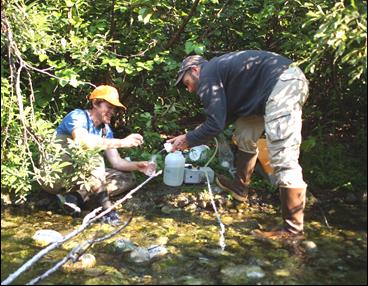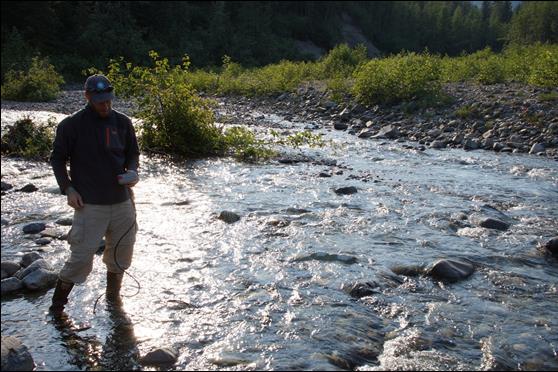How do the food sources utilized by bacteria and animals change as streams develop?
Project Dates
July—December 2013
Did You Know?
Despite their well-known homing instinct, it is not uncommon for salmon to “stray” as they migrate back to spawning grounds. Newly emergent streams become colonized by salmon as a few fish, perhaps encountering adverse conditions in their natal stream, seek out alternate streams for spawning.
Introduction

Glacial retreat has created many new streams and inland aquatic habitats in Glacier Bay over the past 200 years, and new streams are continually forming as glacial retreat continues. This chronosequence of streams has provided, and continues to provide, an excellent opportunity for scientists to study the ecological development of streams.
Stream development has been studied in Glacier Bay for more than 35 years. Professors Eran Hood and Jason Fellman, building on previous work in the park, aim in this study to establish fundamental baseline data on the biogeochemistry of dissolved organic matter in streams. Specifically, the researchers are investigating how the source and chemical composition of dissolved organic matter changes with stream age. This is important for understanding the flow of carbon and energy through stream food webs.
What are the sources of organic matter in post-glacial streams? Ecologists distinguish between “autochthonous” sources (those that develop in place, such as stream algae), and “allochthonous” sources deposited from elsewhere, such as fallen leaves. These two sources have distinct chemical signatures, which are reflected in the chemical composition of organic matter as well as in the animals that eat them. The researchers collected streamwater from several streams of different ages. By analyzing the samples, they are determining to what extent stream food webs may rely on algae vs. land plant material.
The researchers hypothesize that autochthonous sources are most important in the harsh physical conditions of very young streams, but as more plants colonize the stream banks over time, allochthonous sources will become more important to stream ecosystems.
Methods
In July 2013, the researchers sampled 12 streams along a chronosequence of stream age, from about 50 to 1,400 years old, for vital physical and chemical characteristics such as temperature, salinity, and dissolved oxygen content. They also collected surface water samples for analysis of nutrients, the chemical composition of dissolved organic matter, and dissolved greenhouse gases, such as carbon dioxide, methane, and nitrous oxide. All water samples were filtered to remove particulates and coarse organic material.
To study the chemical composition and sources of dissolved organic matter, the researchers measured lignin phenols (biomarkers for terrestrial plant material), radiocarbon age (to determine how old the organic matter is), and stable isotopes of carbon and nitrogen, which are indicators of the source of organic matter to the stream.
Findings

Preliminary results indicate that organic matter concentrations increase with stream age and that, surprisingly, stream temperature decreases as streams increase in age.
Last updated: September 13, 2016
